Australian Tourism and Restaurant - Technology and Innovation
VerifiedAdded on 2022/04/04
|12
|4294
|20
AI Summary
The COVID-19 pandemic has been considered a curse for businesses across the world. This study material is about how the Australian tourism and restaurant sectors are adopting technology and innovation to mitigate the impact of Covid-19. It also includes the role of technology in providing safe service to customers of hospitality and restaurants.
Contribute Materials
Your contribution can guide someone’s learning journey. Share your
documents today.
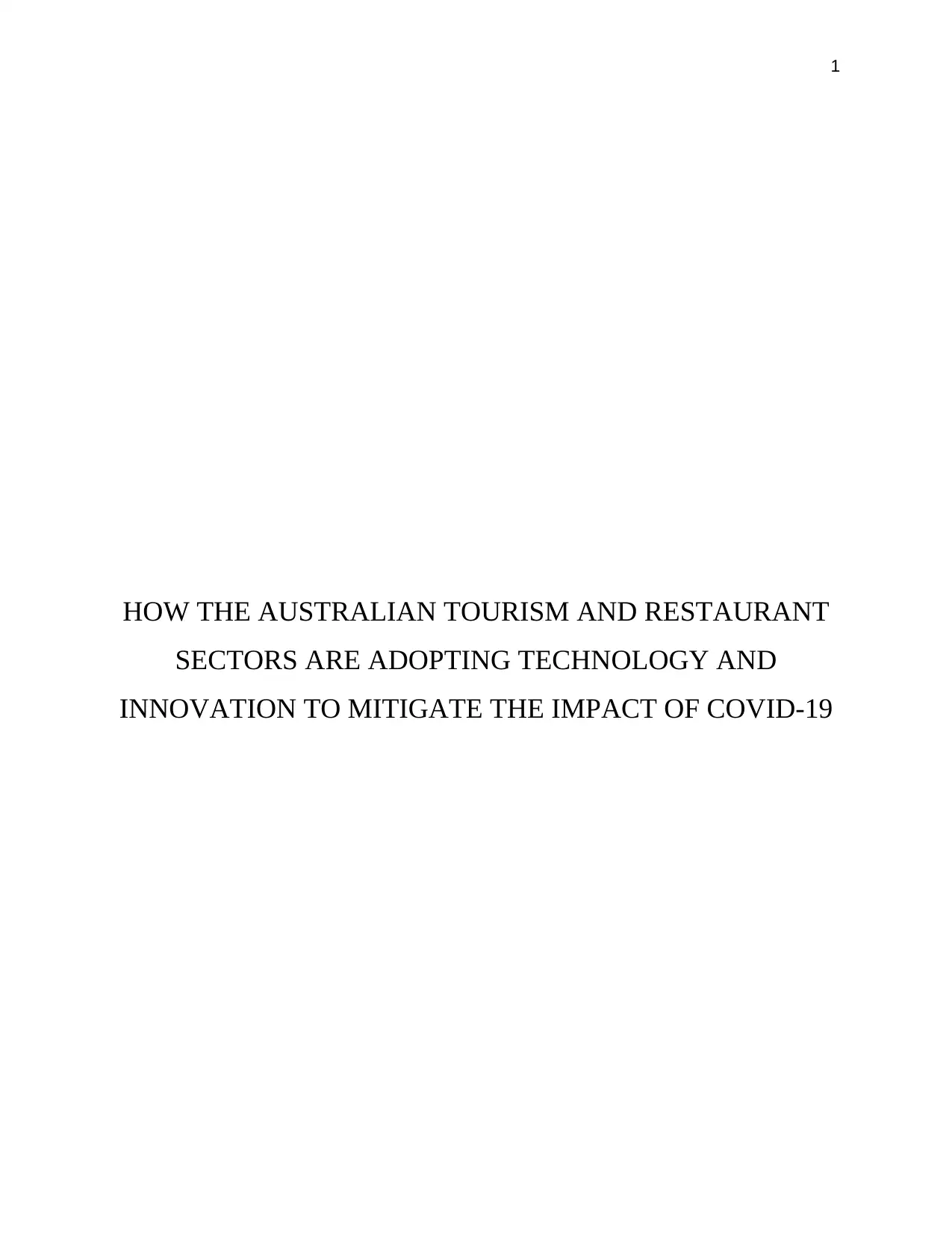
1
HOW THE AUSTRALIAN TOURISM AND RESTAURANT
SECTORS ARE ADOPTING TECHNOLOGY AND
INNOVATION TO MITIGATE THE IMPACT OF COVID-19
HOW THE AUSTRALIAN TOURISM AND RESTAURANT
SECTORS ARE ADOPTING TECHNOLOGY AND
INNOVATION TO MITIGATE THE IMPACT OF COVID-19
Secure Best Marks with AI Grader
Need help grading? Try our AI Grader for instant feedback on your assignments.
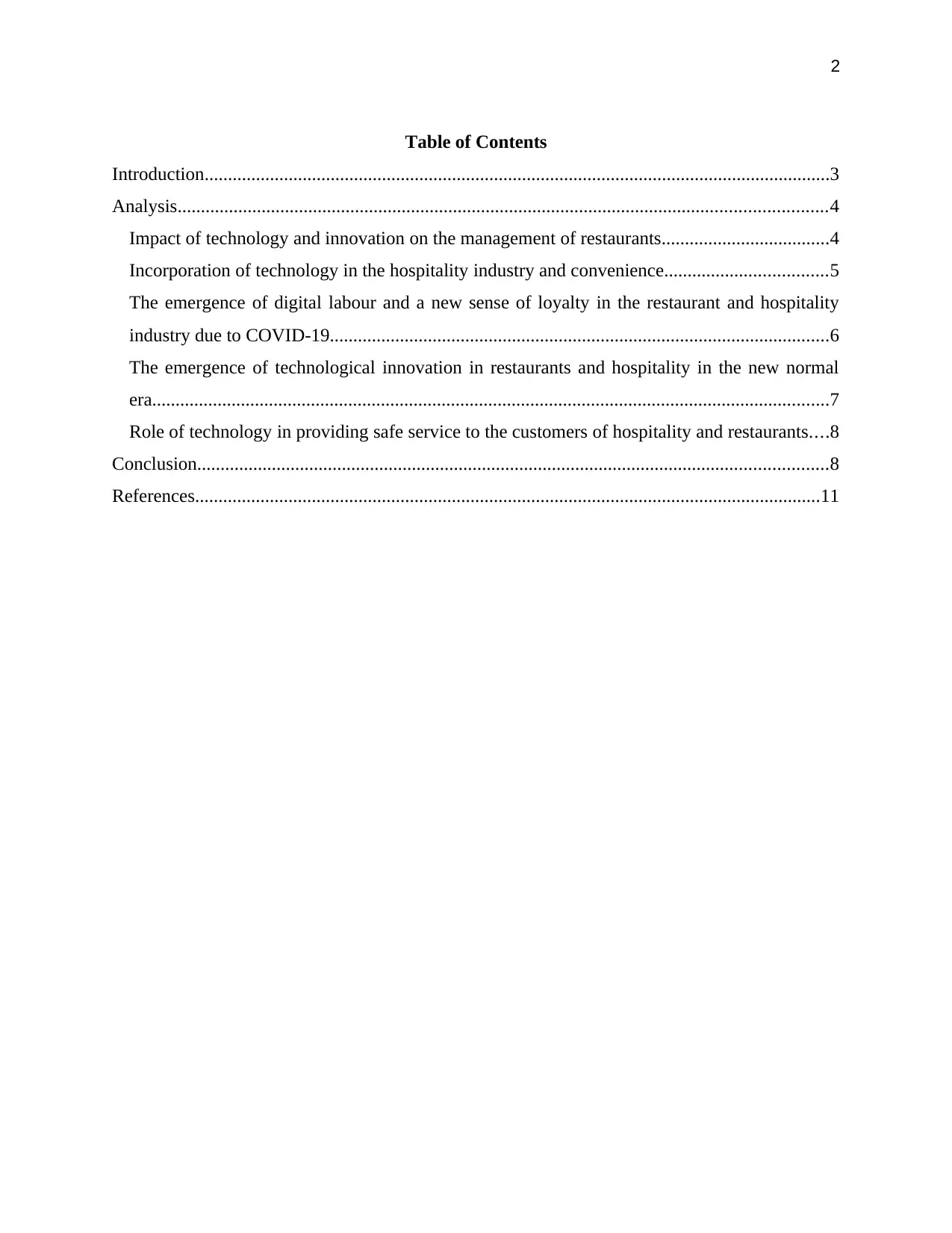
2
Table of Contents
Introduction......................................................................................................................................3
Analysis...........................................................................................................................................4
Impact of technology and innovation on the management of restaurants....................................4
Incorporation of technology in the hospitality industry and convenience...................................5
The emergence of digital labour and a new sense of loyalty in the restaurant and hospitality
industry due to COVID-19...........................................................................................................6
The emergence of technological innovation in restaurants and hospitality in the new normal
era.................................................................................................................................................7
Role of technology in providing safe service to the customers of hospitality and restaurants....8
Conclusion.......................................................................................................................................8
References......................................................................................................................................11
Table of Contents
Introduction......................................................................................................................................3
Analysis...........................................................................................................................................4
Impact of technology and innovation on the management of restaurants....................................4
Incorporation of technology in the hospitality industry and convenience...................................5
The emergence of digital labour and a new sense of loyalty in the restaurant and hospitality
industry due to COVID-19...........................................................................................................6
The emergence of technological innovation in restaurants and hospitality in the new normal
era.................................................................................................................................................7
Role of technology in providing safe service to the customers of hospitality and restaurants....8
Conclusion.......................................................................................................................................8
References......................................................................................................................................11
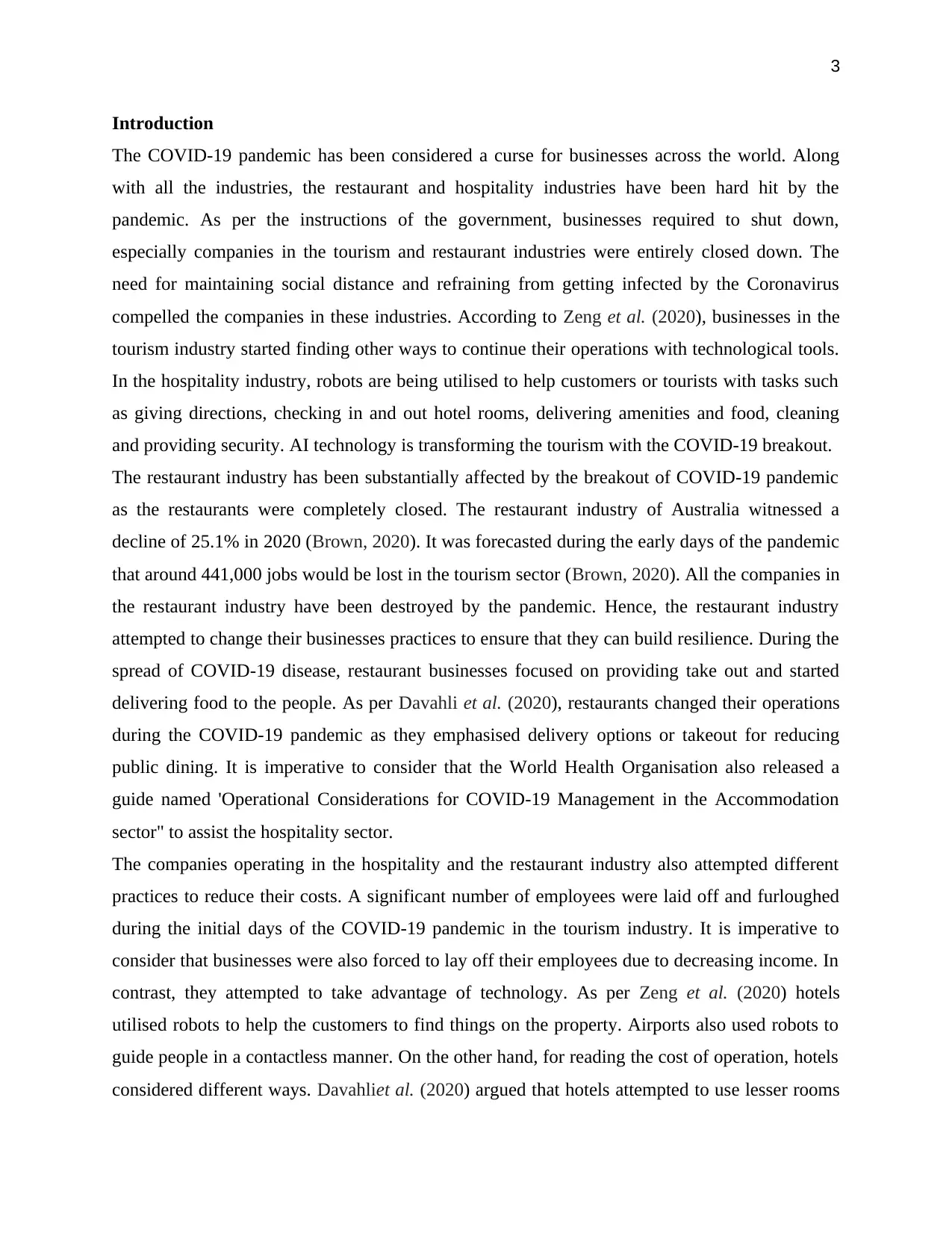
3
Introduction
The COVID-19 pandemic has been considered a curse for businesses across the world. Along
with all the industries, the restaurant and hospitality industries have been hard hit by the
pandemic. As per the instructions of the government, businesses required to shut down,
especially companies in the tourism and restaurant industries were entirely closed down. The
need for maintaining social distance and refraining from getting infected by the Coronavirus
compelled the companies in these industries. According to Zeng et al. (2020), businesses in the
tourism industry started finding other ways to continue their operations with technological tools.
In the hospitality industry, robots are being utilised to help customers or tourists with tasks such
as giving directions, checking in and out hotel rooms, delivering amenities and food, cleaning
and providing security. AI technology is transforming the tourism with the COVID-19 breakout.
The restaurant industry has been substantially affected by the breakout of COVID-19 pandemic
as the restaurants were completely closed. The restaurant industry of Australia witnessed a
decline of 25.1% in 2020 (Brown, 2020). It was forecasted during the early days of the pandemic
that around 441,000 jobs would be lost in the tourism sector (Brown, 2020). All the companies in
the restaurant industry have been destroyed by the pandemic. Hence, the restaurant industry
attempted to change their businesses practices to ensure that they can build resilience. During the
spread of COVID-19 disease, restaurant businesses focused on providing take out and started
delivering food to the people. As per Davahli et al. (2020), restaurants changed their operations
during the COVID-19 pandemic as they emphasised delivery options or takeout for reducing
public dining. It is imperative to consider that the World Health Organisation also released a
guide named 'Operational Considerations for COVID-19 Management in the Accommodation
sector" to assist the hospitality sector.
The companies operating in the hospitality and the restaurant industry also attempted different
practices to reduce their costs. A significant number of employees were laid off and furloughed
during the initial days of the COVID-19 pandemic in the tourism industry. It is imperative to
consider that businesses were also forced to lay off their employees due to decreasing income. In
contrast, they attempted to take advantage of technology. As per Zeng et al. (2020) hotels
utilised robots to help the customers to find things on the property. Airports also used robots to
guide people in a contactless manner. On the other hand, for reading the cost of operation, hotels
considered different ways. Davahliet al. (2020) argued that hotels attempted to use lesser rooms
Introduction
The COVID-19 pandemic has been considered a curse for businesses across the world. Along
with all the industries, the restaurant and hospitality industries have been hard hit by the
pandemic. As per the instructions of the government, businesses required to shut down,
especially companies in the tourism and restaurant industries were entirely closed down. The
need for maintaining social distance and refraining from getting infected by the Coronavirus
compelled the companies in these industries. According to Zeng et al. (2020), businesses in the
tourism industry started finding other ways to continue their operations with technological tools.
In the hospitality industry, robots are being utilised to help customers or tourists with tasks such
as giving directions, checking in and out hotel rooms, delivering amenities and food, cleaning
and providing security. AI technology is transforming the tourism with the COVID-19 breakout.
The restaurant industry has been substantially affected by the breakout of COVID-19 pandemic
as the restaurants were completely closed. The restaurant industry of Australia witnessed a
decline of 25.1% in 2020 (Brown, 2020). It was forecasted during the early days of the pandemic
that around 441,000 jobs would be lost in the tourism sector (Brown, 2020). All the companies in
the restaurant industry have been destroyed by the pandemic. Hence, the restaurant industry
attempted to change their businesses practices to ensure that they can build resilience. During the
spread of COVID-19 disease, restaurant businesses focused on providing take out and started
delivering food to the people. As per Davahli et al. (2020), restaurants changed their operations
during the COVID-19 pandemic as they emphasised delivery options or takeout for reducing
public dining. It is imperative to consider that the World Health Organisation also released a
guide named 'Operational Considerations for COVID-19 Management in the Accommodation
sector" to assist the hospitality sector.
The companies operating in the hospitality and the restaurant industry also attempted different
practices to reduce their costs. A significant number of employees were laid off and furloughed
during the initial days of the COVID-19 pandemic in the tourism industry. It is imperative to
consider that businesses were also forced to lay off their employees due to decreasing income. In
contrast, they attempted to take advantage of technology. As per Zeng et al. (2020) hotels
utilised robots to help the customers to find things on the property. Airports also used robots to
guide people in a contactless manner. On the other hand, for reading the cost of operation, hotels
considered different ways. Davahliet al. (2020) argued that hotels attempted to use lesser rooms
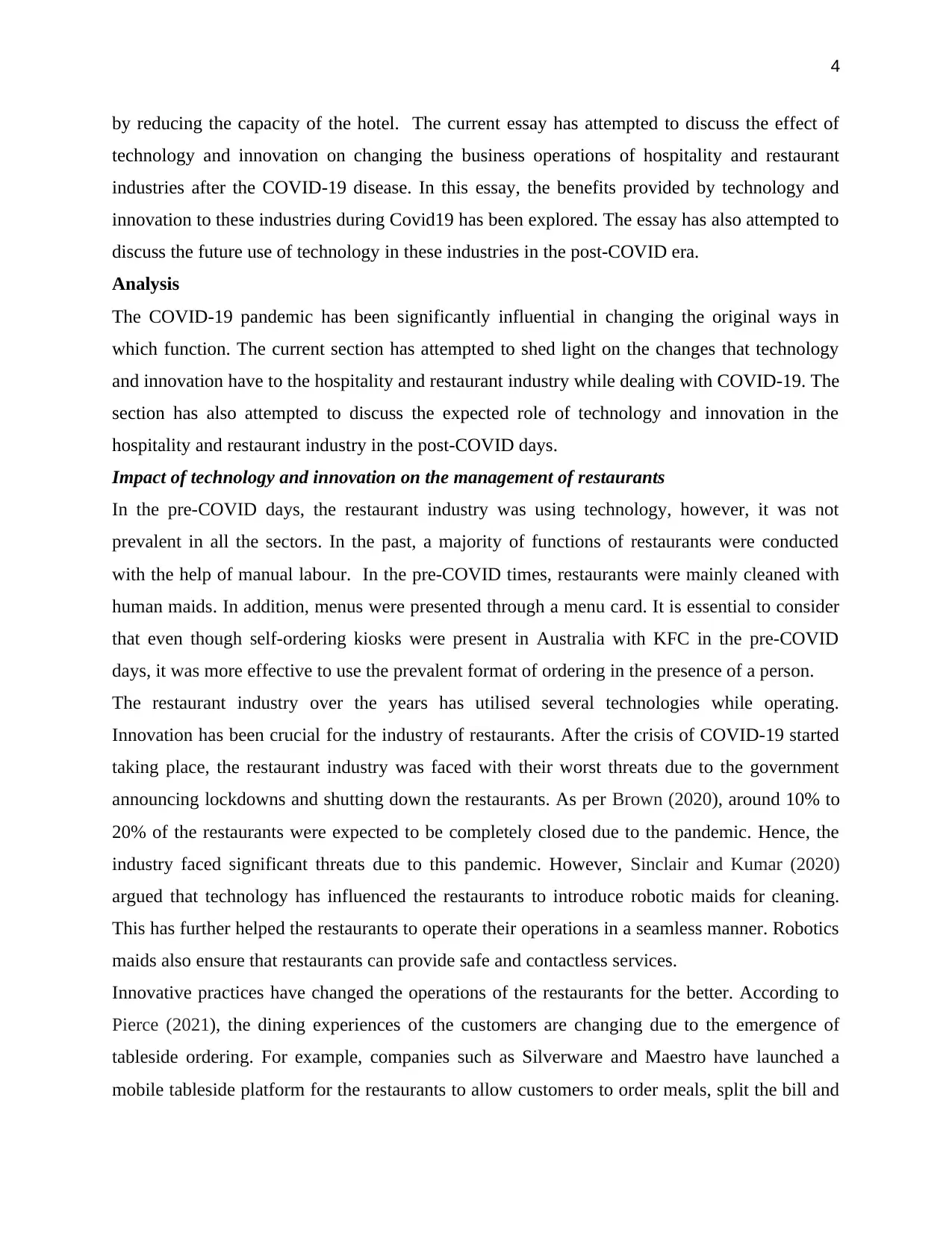
4
by reducing the capacity of the hotel. The current essay has attempted to discuss the effect of
technology and innovation on changing the business operations of hospitality and restaurant
industries after the COVID-19 disease. In this essay, the benefits provided by technology and
innovation to these industries during Covid19 has been explored. The essay has also attempted to
discuss the future use of technology in these industries in the post-COVID era.
Analysis
The COVID-19 pandemic has been significantly influential in changing the original ways in
which function. The current section has attempted to shed light on the changes that technology
and innovation have to the hospitality and restaurant industry while dealing with COVID-19. The
section has also attempted to discuss the expected role of technology and innovation in the
hospitality and restaurant industry in the post-COVID days.
Impact of technology and innovation on the management of restaurants
In the pre-COVID days, the restaurant industry was using technology, however, it was not
prevalent in all the sectors. In the past, a majority of functions of restaurants were conducted
with the help of manual labour. In the pre-COVID times, restaurants were mainly cleaned with
human maids. In addition, menus were presented through a menu card. It is essential to consider
that even though self-ordering kiosks were present in Australia with KFC in the pre-COVID
days, it was more effective to use the prevalent format of ordering in the presence of a person.
The restaurant industry over the years has utilised several technologies while operating.
Innovation has been crucial for the industry of restaurants. After the crisis of COVID-19 started
taking place, the restaurant industry was faced with their worst threats due to the government
announcing lockdowns and shutting down the restaurants. As per Brown (2020), around 10% to
20% of the restaurants were expected to be completely closed due to the pandemic. Hence, the
industry faced significant threats due to this pandemic. However, Sinclair and Kumar (2020)
argued that technology has influenced the restaurants to introduce robotic maids for cleaning.
This has further helped the restaurants to operate their operations in a seamless manner. Robotics
maids also ensure that restaurants can provide safe and contactless services.
Innovative practices have changed the operations of the restaurants for the better. According to
Pierce (2021), the dining experiences of the customers are changing due to the emergence of
tableside ordering. For example, companies such as Silverware and Maestro have launched a
mobile tableside platform for the restaurants to allow customers to order meals, split the bill and
by reducing the capacity of the hotel. The current essay has attempted to discuss the effect of
technology and innovation on changing the business operations of hospitality and restaurant
industries after the COVID-19 disease. In this essay, the benefits provided by technology and
innovation to these industries during Covid19 has been explored. The essay has also attempted to
discuss the future use of technology in these industries in the post-COVID era.
Analysis
The COVID-19 pandemic has been significantly influential in changing the original ways in
which function. The current section has attempted to shed light on the changes that technology
and innovation have to the hospitality and restaurant industry while dealing with COVID-19. The
section has also attempted to discuss the expected role of technology and innovation in the
hospitality and restaurant industry in the post-COVID days.
Impact of technology and innovation on the management of restaurants
In the pre-COVID days, the restaurant industry was using technology, however, it was not
prevalent in all the sectors. In the past, a majority of functions of restaurants were conducted
with the help of manual labour. In the pre-COVID times, restaurants were mainly cleaned with
human maids. In addition, menus were presented through a menu card. It is essential to consider
that even though self-ordering kiosks were present in Australia with KFC in the pre-COVID
days, it was more effective to use the prevalent format of ordering in the presence of a person.
The restaurant industry over the years has utilised several technologies while operating.
Innovation has been crucial for the industry of restaurants. After the crisis of COVID-19 started
taking place, the restaurant industry was faced with their worst threats due to the government
announcing lockdowns and shutting down the restaurants. As per Brown (2020), around 10% to
20% of the restaurants were expected to be completely closed due to the pandemic. Hence, the
industry faced significant threats due to this pandemic. However, Sinclair and Kumar (2020)
argued that technology has influenced the restaurants to introduce robotic maids for cleaning.
This has further helped the restaurants to operate their operations in a seamless manner. Robotics
maids also ensure that restaurants can provide safe and contactless services.
Innovative practices have changed the operations of the restaurants for the better. According to
Pierce (2021), the dining experiences of the customers are changing due to the emergence of
tableside ordering. For example, companies such as Silverware and Maestro have launched a
mobile tableside platform for the restaurants to allow customers to order meals, split the bill and
Secure Best Marks with AI Grader
Need help grading? Try our AI Grader for instant feedback on your assignments.
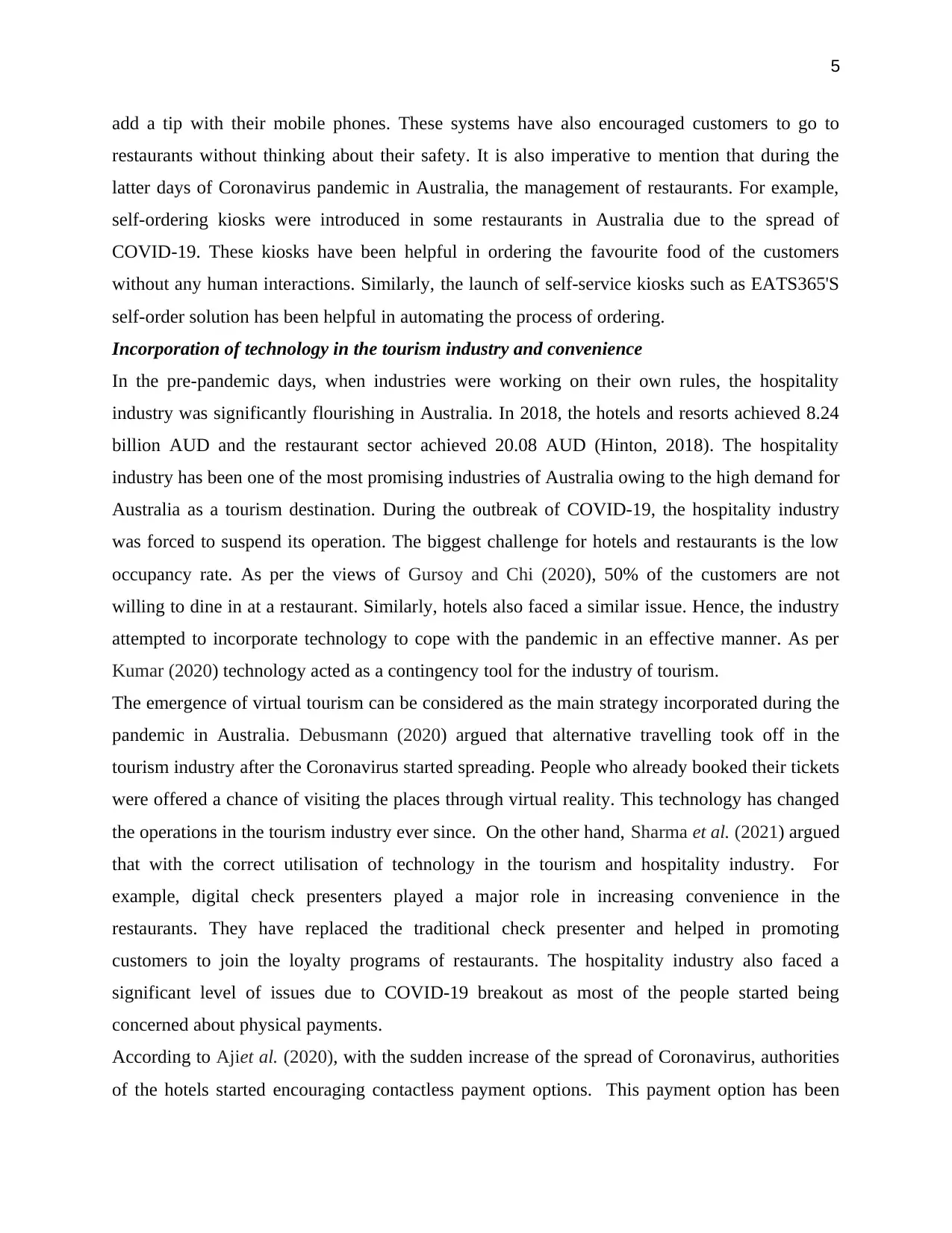
5
add a tip with their mobile phones. These systems have also encouraged customers to go to
restaurants without thinking about their safety. It is also imperative to mention that during the
latter days of Coronavirus pandemic in Australia, the management of restaurants. For example,
self-ordering kiosks were introduced in some restaurants in Australia due to the spread of
COVID-19. These kiosks have been helpful in ordering the favourite food of the customers
without any human interactions. Similarly, the launch of self-service kiosks such as EATS365'S
self-order solution has been helpful in automating the process of ordering.
Incorporation of technology in the tourism industry and convenience
In the pre-pandemic days, when industries were working on their own rules, the hospitality
industry was significantly flourishing in Australia. In 2018, the hotels and resorts achieved 8.24
billion AUD and the restaurant sector achieved 20.08 AUD (Hinton, 2018). The hospitality
industry has been one of the most promising industries of Australia owing to the high demand for
Australia as a tourism destination. During the outbreak of COVID-19, the hospitality industry
was forced to suspend its operation. The biggest challenge for hotels and restaurants is the low
occupancy rate. As per the views of Gursoy and Chi (2020), 50% of the customers are not
willing to dine in at a restaurant. Similarly, hotels also faced a similar issue. Hence, the industry
attempted to incorporate technology to cope with the pandemic in an effective manner. As per
Kumar (2020) technology acted as a contingency tool for the industry of tourism.
The emergence of virtual tourism can be considered as the main strategy incorporated during the
pandemic in Australia. Debusmann (2020) argued that alternative travelling took off in the
tourism industry after the Coronavirus started spreading. People who already booked their tickets
were offered a chance of visiting the places through virtual reality. This technology has changed
the operations in the tourism industry ever since. On the other hand, Sharma et al. (2021) argued
that with the correct utilisation of technology in the tourism and hospitality industry. For
example, digital check presenters played a major role in increasing convenience in the
restaurants. They have replaced the traditional check presenter and helped in promoting
customers to join the loyalty programs of restaurants. The hospitality industry also faced a
significant level of issues due to COVID-19 breakout as most of the people started being
concerned about physical payments.
According to Ajiet al. (2020), with the sudden increase of the spread of Coronavirus, authorities
of the hotels started encouraging contactless payment options. This payment option has been
add a tip with their mobile phones. These systems have also encouraged customers to go to
restaurants without thinking about their safety. It is also imperative to mention that during the
latter days of Coronavirus pandemic in Australia, the management of restaurants. For example,
self-ordering kiosks were introduced in some restaurants in Australia due to the spread of
COVID-19. These kiosks have been helpful in ordering the favourite food of the customers
without any human interactions. Similarly, the launch of self-service kiosks such as EATS365'S
self-order solution has been helpful in automating the process of ordering.
Incorporation of technology in the tourism industry and convenience
In the pre-pandemic days, when industries were working on their own rules, the hospitality
industry was significantly flourishing in Australia. In 2018, the hotels and resorts achieved 8.24
billion AUD and the restaurant sector achieved 20.08 AUD (Hinton, 2018). The hospitality
industry has been one of the most promising industries of Australia owing to the high demand for
Australia as a tourism destination. During the outbreak of COVID-19, the hospitality industry
was forced to suspend its operation. The biggest challenge for hotels and restaurants is the low
occupancy rate. As per the views of Gursoy and Chi (2020), 50% of the customers are not
willing to dine in at a restaurant. Similarly, hotels also faced a similar issue. Hence, the industry
attempted to incorporate technology to cope with the pandemic in an effective manner. As per
Kumar (2020) technology acted as a contingency tool for the industry of tourism.
The emergence of virtual tourism can be considered as the main strategy incorporated during the
pandemic in Australia. Debusmann (2020) argued that alternative travelling took off in the
tourism industry after the Coronavirus started spreading. People who already booked their tickets
were offered a chance of visiting the places through virtual reality. This technology has changed
the operations in the tourism industry ever since. On the other hand, Sharma et al. (2021) argued
that with the correct utilisation of technology in the tourism and hospitality industry. For
example, digital check presenters played a major role in increasing convenience in the
restaurants. They have replaced the traditional check presenter and helped in promoting
customers to join the loyalty programs of restaurants. The hospitality industry also faced a
significant level of issues due to COVID-19 breakout as most of the people started being
concerned about physical payments.
According to Ajiet al. (2020), with the sudden increase of the spread of Coronavirus, authorities
of the hotels started encouraging contactless payment options. This payment option has been
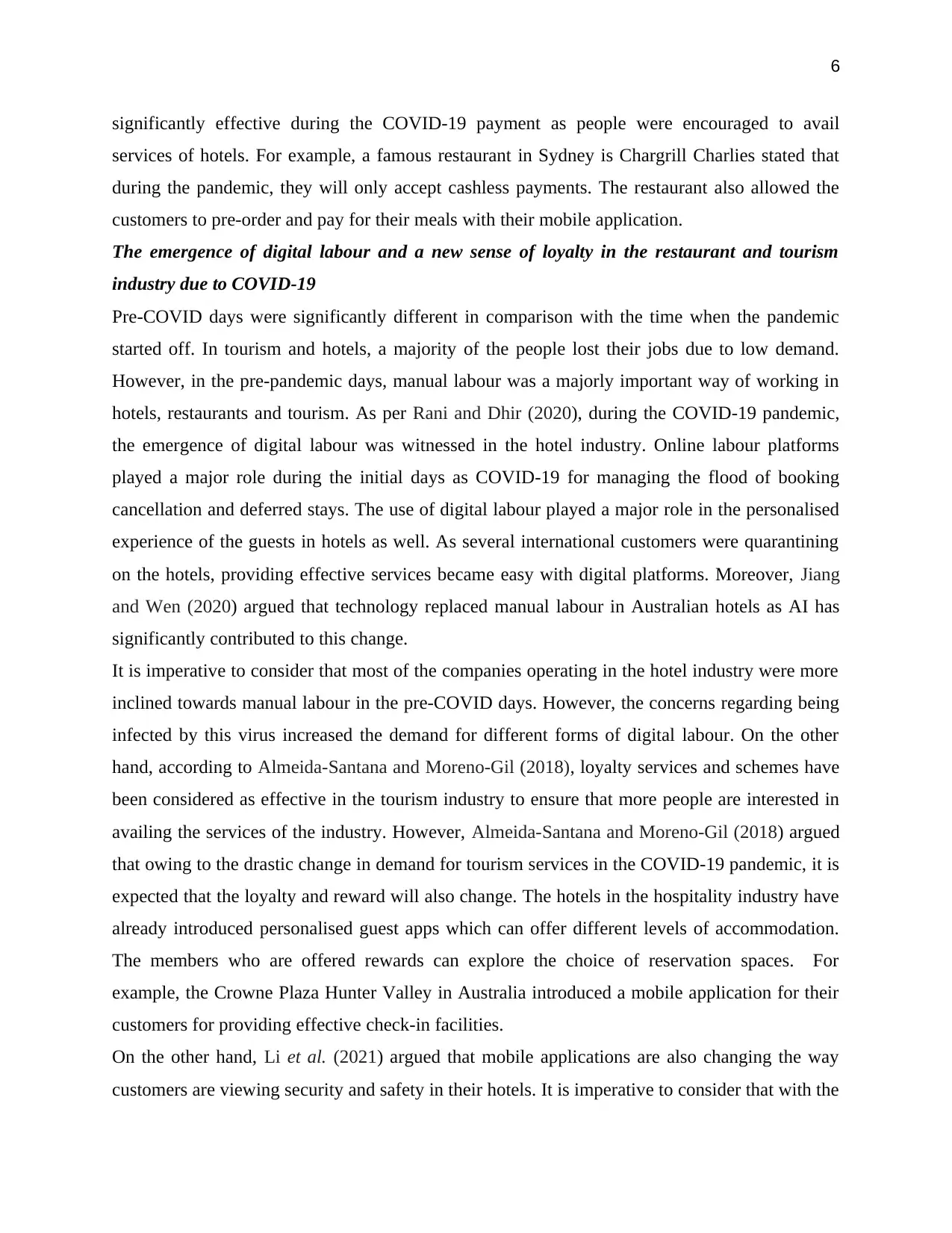
6
significantly effective during the COVID-19 payment as people were encouraged to avail
services of hotels. For example, a famous restaurant in Sydney is Chargrill Charlies stated that
during the pandemic, they will only accept cashless payments. The restaurant also allowed the
customers to pre-order and pay for their meals with their mobile application.
The emergence of digital labour and a new sense of loyalty in the restaurant and tourism
industry due to COVID-19
Pre-COVID days were significantly different in comparison with the time when the pandemic
started off. In tourism and hotels, a majority of the people lost their jobs due to low demand.
However, in the pre-pandemic days, manual labour was a majorly important way of working in
hotels, restaurants and tourism. As per Rani and Dhir (2020), during the COVID-19 pandemic,
the emergence of digital labour was witnessed in the hotel industry. Online labour platforms
played a major role during the initial days as COVID-19 for managing the flood of booking
cancellation and deferred stays. The use of digital labour played a major role in the personalised
experience of the guests in hotels as well. As several international customers were quarantining
on the hotels, providing effective services became easy with digital platforms. Moreover, Jiang
and Wen (2020) argued that technology replaced manual labour in Australian hotels as AI has
significantly contributed to this change.
It is imperative to consider that most of the companies operating in the hotel industry were more
inclined towards manual labour in the pre-COVID days. However, the concerns regarding being
infected by this virus increased the demand for different forms of digital labour. On the other
hand, according to Almeida-Santana and Moreno-Gil (2018), loyalty services and schemes have
been considered as effective in the tourism industry to ensure that more people are interested in
availing the services of the industry. However, Almeida-Santana and Moreno-Gil (2018) argued
that owing to the drastic change in demand for tourism services in the COVID-19 pandemic, it is
expected that the loyalty and reward will also change. The hotels in the hospitality industry have
already introduced personalised guest apps which can offer different levels of accommodation.
The members who are offered rewards can explore the choice of reservation spaces. For
example, the Crowne Plaza Hunter Valley in Australia introduced a mobile application for their
customers for providing effective check-in facilities.
On the other hand, Li et al. (2021) argued that mobile applications are also changing the way
customers are viewing security and safety in their hotels. It is imperative to consider that with the
significantly effective during the COVID-19 payment as people were encouraged to avail
services of hotels. For example, a famous restaurant in Sydney is Chargrill Charlies stated that
during the pandemic, they will only accept cashless payments. The restaurant also allowed the
customers to pre-order and pay for their meals with their mobile application.
The emergence of digital labour and a new sense of loyalty in the restaurant and tourism
industry due to COVID-19
Pre-COVID days were significantly different in comparison with the time when the pandemic
started off. In tourism and hotels, a majority of the people lost their jobs due to low demand.
However, in the pre-pandemic days, manual labour was a majorly important way of working in
hotels, restaurants and tourism. As per Rani and Dhir (2020), during the COVID-19 pandemic,
the emergence of digital labour was witnessed in the hotel industry. Online labour platforms
played a major role during the initial days as COVID-19 for managing the flood of booking
cancellation and deferred stays. The use of digital labour played a major role in the personalised
experience of the guests in hotels as well. As several international customers were quarantining
on the hotels, providing effective services became easy with digital platforms. Moreover, Jiang
and Wen (2020) argued that technology replaced manual labour in Australian hotels as AI has
significantly contributed to this change.
It is imperative to consider that most of the companies operating in the hotel industry were more
inclined towards manual labour in the pre-COVID days. However, the concerns regarding being
infected by this virus increased the demand for different forms of digital labour. On the other
hand, according to Almeida-Santana and Moreno-Gil (2018), loyalty services and schemes have
been considered as effective in the tourism industry to ensure that more people are interested in
availing the services of the industry. However, Almeida-Santana and Moreno-Gil (2018) argued
that owing to the drastic change in demand for tourism services in the COVID-19 pandemic, it is
expected that the loyalty and reward will also change. The hotels in the hospitality industry have
already introduced personalised guest apps which can offer different levels of accommodation.
The members who are offered rewards can explore the choice of reservation spaces. For
example, the Crowne Plaza Hunter Valley in Australia introduced a mobile application for their
customers for providing effective check-in facilities.
On the other hand, Li et al. (2021) argued that mobile applications are also changing the way
customers are viewing security and safety in their hotels. It is imperative to consider that with the
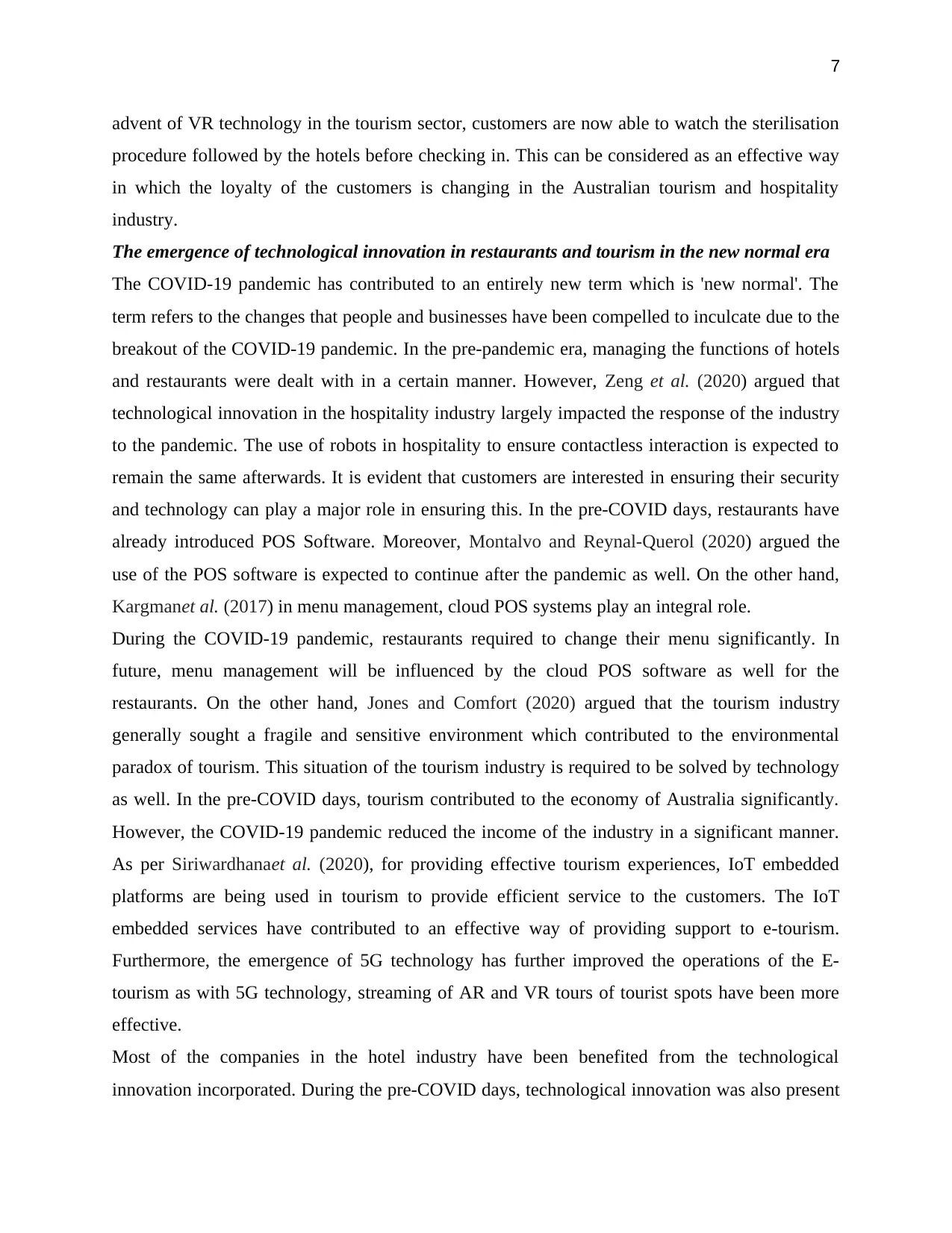
7
advent of VR technology in the tourism sector, customers are now able to watch the sterilisation
procedure followed by the hotels before checking in. This can be considered as an effective way
in which the loyalty of the customers is changing in the Australian tourism and hospitality
industry.
The emergence of technological innovation in restaurants and tourism in the new normal era
The COVID-19 pandemic has contributed to an entirely new term which is 'new normal'. The
term refers to the changes that people and businesses have been compelled to inculcate due to the
breakout of the COVID-19 pandemic. In the pre-pandemic era, managing the functions of hotels
and restaurants were dealt with in a certain manner. However, Zeng et al. (2020) argued that
technological innovation in the hospitality industry largely impacted the response of the industry
to the pandemic. The use of robots in hospitality to ensure contactless interaction is expected to
remain the same afterwards. It is evident that customers are interested in ensuring their security
and technology can play a major role in ensuring this. In the pre-COVID days, restaurants have
already introduced POS Software. Moreover, Montalvo and Reynal-Querol (2020) argued the
use of the POS software is expected to continue after the pandemic as well. On the other hand,
Kargmanet al. (2017) in menu management, cloud POS systems play an integral role.
During the COVID-19 pandemic, restaurants required to change their menu significantly. In
future, menu management will be influenced by the cloud POS software as well for the
restaurants. On the other hand, Jones and Comfort (2020) argued that the tourism industry
generally sought a fragile and sensitive environment which contributed to the environmental
paradox of tourism. This situation of the tourism industry is required to be solved by technology
as well. In the pre-COVID days, tourism contributed to the economy of Australia significantly.
However, the COVID-19 pandemic reduced the income of the industry in a significant manner.
As per Siriwardhanaet al. (2020), for providing effective tourism experiences, IoT embedded
platforms are being used in tourism to provide efficient service to the customers. The IoT
embedded services have contributed to an effective way of providing support to e-tourism.
Furthermore, the emergence of 5G technology has further improved the operations of the E-
tourism as with 5G technology, streaming of AR and VR tours of tourist spots have been more
effective.
Most of the companies in the hotel industry have been benefited from the technological
innovation incorporated. During the pre-COVID days, technological innovation was also present
advent of VR technology in the tourism sector, customers are now able to watch the sterilisation
procedure followed by the hotels before checking in. This can be considered as an effective way
in which the loyalty of the customers is changing in the Australian tourism and hospitality
industry.
The emergence of technological innovation in restaurants and tourism in the new normal era
The COVID-19 pandemic has contributed to an entirely new term which is 'new normal'. The
term refers to the changes that people and businesses have been compelled to inculcate due to the
breakout of the COVID-19 pandemic. In the pre-pandemic era, managing the functions of hotels
and restaurants were dealt with in a certain manner. However, Zeng et al. (2020) argued that
technological innovation in the hospitality industry largely impacted the response of the industry
to the pandemic. The use of robots in hospitality to ensure contactless interaction is expected to
remain the same afterwards. It is evident that customers are interested in ensuring their security
and technology can play a major role in ensuring this. In the pre-COVID days, restaurants have
already introduced POS Software. Moreover, Montalvo and Reynal-Querol (2020) argued the
use of the POS software is expected to continue after the pandemic as well. On the other hand,
Kargmanet al. (2017) in menu management, cloud POS systems play an integral role.
During the COVID-19 pandemic, restaurants required to change their menu significantly. In
future, menu management will be influenced by the cloud POS software as well for the
restaurants. On the other hand, Jones and Comfort (2020) argued that the tourism industry
generally sought a fragile and sensitive environment which contributed to the environmental
paradox of tourism. This situation of the tourism industry is required to be solved by technology
as well. In the pre-COVID days, tourism contributed to the economy of Australia significantly.
However, the COVID-19 pandemic reduced the income of the industry in a significant manner.
As per Siriwardhanaet al. (2020), for providing effective tourism experiences, IoT embedded
platforms are being used in tourism to provide efficient service to the customers. The IoT
embedded services have contributed to an effective way of providing support to e-tourism.
Furthermore, the emergence of 5G technology has further improved the operations of the E-
tourism as with 5G technology, streaming of AR and VR tours of tourist spots have been more
effective.
Most of the companies in the hotel industry have been benefited from the technological
innovation incorporated. During the pre-COVID days, technological innovation was also present
Paraphrase This Document
Need a fresh take? Get an instant paraphrase of this document with our AI Paraphraser
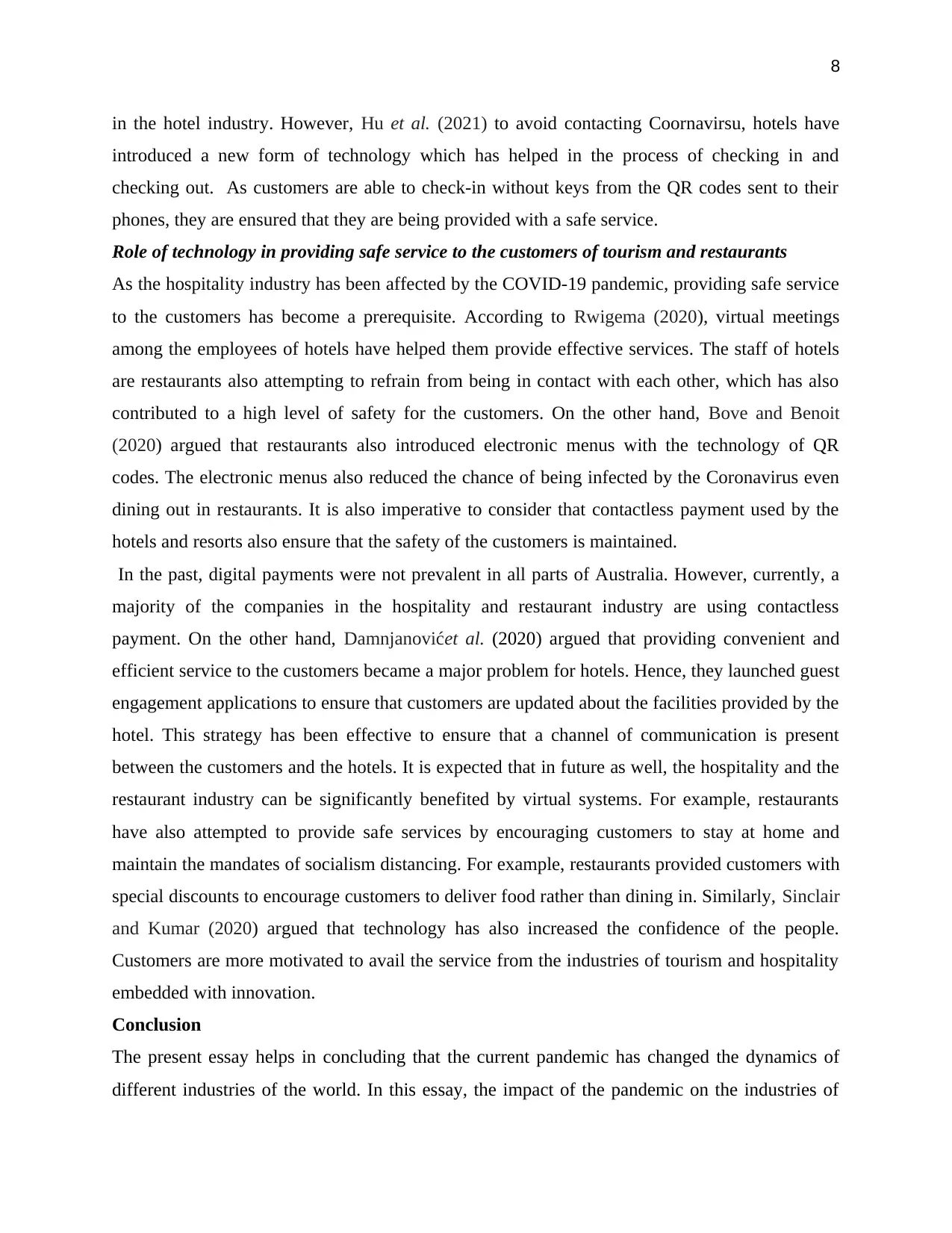
8
in the hotel industry. However, Hu et al. (2021) to avoid contacting Coornavirsu, hotels have
introduced a new form of technology which has helped in the process of checking in and
checking out. As customers are able to check-in without keys from the QR codes sent to their
phones, they are ensured that they are being provided with a safe service.
Role of technology in providing safe service to the customers of tourism and restaurants
As the hospitality industry has been affected by the COVID-19 pandemic, providing safe service
to the customers has become a prerequisite. According to Rwigema (2020), virtual meetings
among the employees of hotels have helped them provide effective services. The staff of hotels
are restaurants also attempting to refrain from being in contact with each other, which has also
contributed to a high level of safety for the customers. On the other hand, Bove and Benoit
(2020) argued that restaurants also introduced electronic menus with the technology of QR
codes. The electronic menus also reduced the chance of being infected by the Coronavirus even
dining out in restaurants. It is also imperative to consider that contactless payment used by the
hotels and resorts also ensure that the safety of the customers is maintained.
In the past, digital payments were not prevalent in all parts of Australia. However, currently, a
majority of the companies in the hospitality and restaurant industry are using contactless
payment. On the other hand, Damnjanovićet al. (2020) argued that providing convenient and
efficient service to the customers became a major problem for hotels. Hence, they launched guest
engagement applications to ensure that customers are updated about the facilities provided by the
hotel. This strategy has been effective to ensure that a channel of communication is present
between the customers and the hotels. It is expected that in future as well, the hospitality and the
restaurant industry can be significantly benefited by virtual systems. For example, restaurants
have also attempted to provide safe services by encouraging customers to stay at home and
maintain the mandates of socialism distancing. For example, restaurants provided customers with
special discounts to encourage customers to deliver food rather than dining in. Similarly, Sinclair
and Kumar (2020) argued that technology has also increased the confidence of the people.
Customers are more motivated to avail the service from the industries of tourism and hospitality
embedded with innovation.
Conclusion
The present essay helps in concluding that the current pandemic has changed the dynamics of
different industries of the world. In this essay, the impact of the pandemic on the industries of
in the hotel industry. However, Hu et al. (2021) to avoid contacting Coornavirsu, hotels have
introduced a new form of technology which has helped in the process of checking in and
checking out. As customers are able to check-in without keys from the QR codes sent to their
phones, they are ensured that they are being provided with a safe service.
Role of technology in providing safe service to the customers of tourism and restaurants
As the hospitality industry has been affected by the COVID-19 pandemic, providing safe service
to the customers has become a prerequisite. According to Rwigema (2020), virtual meetings
among the employees of hotels have helped them provide effective services. The staff of hotels
are restaurants also attempting to refrain from being in contact with each other, which has also
contributed to a high level of safety for the customers. On the other hand, Bove and Benoit
(2020) argued that restaurants also introduced electronic menus with the technology of QR
codes. The electronic menus also reduced the chance of being infected by the Coronavirus even
dining out in restaurants. It is also imperative to consider that contactless payment used by the
hotels and resorts also ensure that the safety of the customers is maintained.
In the past, digital payments were not prevalent in all parts of Australia. However, currently, a
majority of the companies in the hospitality and restaurant industry are using contactless
payment. On the other hand, Damnjanovićet al. (2020) argued that providing convenient and
efficient service to the customers became a major problem for hotels. Hence, they launched guest
engagement applications to ensure that customers are updated about the facilities provided by the
hotel. This strategy has been effective to ensure that a channel of communication is present
between the customers and the hotels. It is expected that in future as well, the hospitality and the
restaurant industry can be significantly benefited by virtual systems. For example, restaurants
have also attempted to provide safe services by encouraging customers to stay at home and
maintain the mandates of socialism distancing. For example, restaurants provided customers with
special discounts to encourage customers to deliver food rather than dining in. Similarly, Sinclair
and Kumar (2020) argued that technology has also increased the confidence of the people.
Customers are more motivated to avail the service from the industries of tourism and hospitality
embedded with innovation.
Conclusion
The present essay helps in concluding that the current pandemic has changed the dynamics of
different industries of the world. In this essay, the impact of the pandemic on the industries of
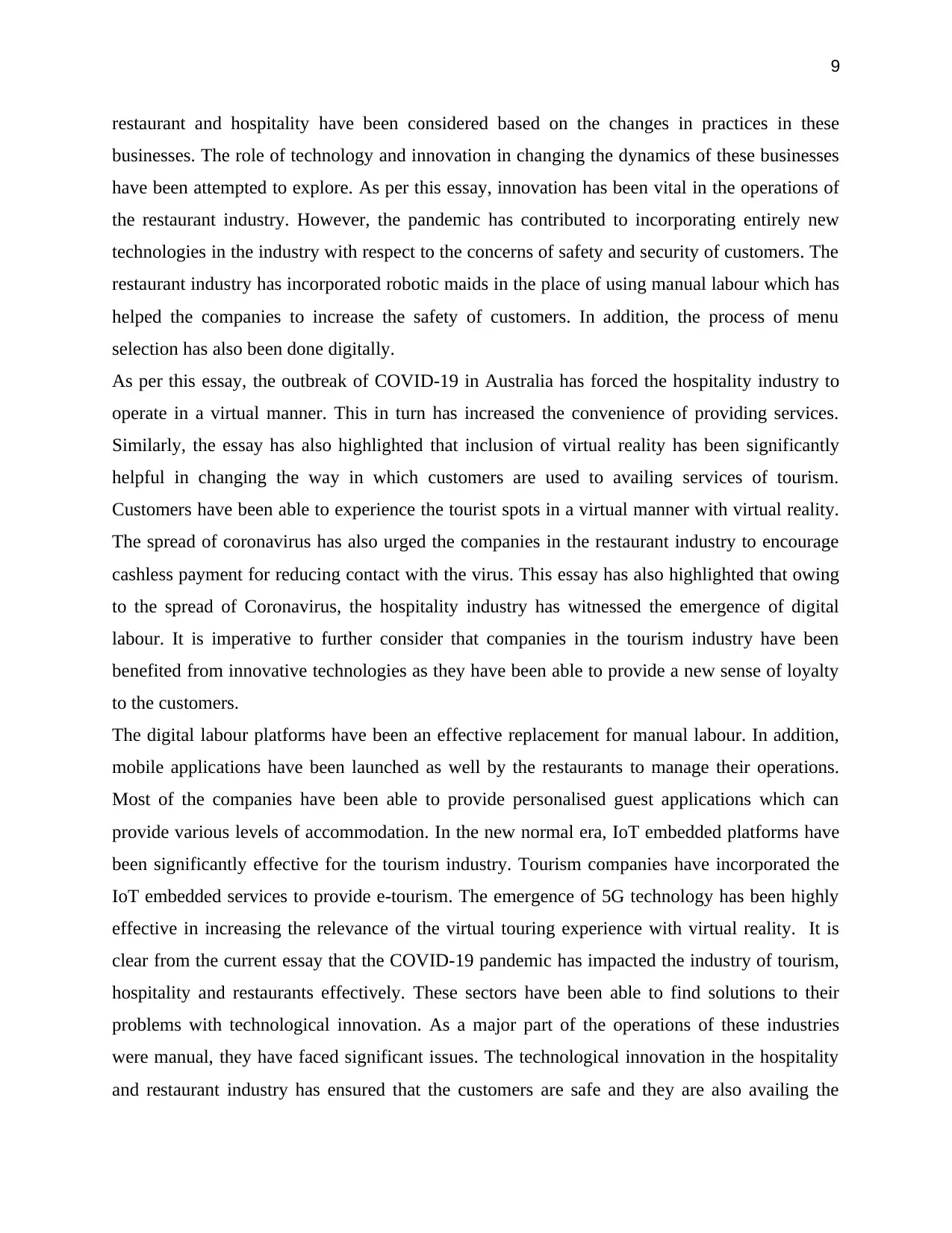
9
restaurant and hospitality have been considered based on the changes in practices in these
businesses. The role of technology and innovation in changing the dynamics of these businesses
have been attempted to explore. As per this essay, innovation has been vital in the operations of
the restaurant industry. However, the pandemic has contributed to incorporating entirely new
technologies in the industry with respect to the concerns of safety and security of customers. The
restaurant industry has incorporated robotic maids in the place of using manual labour which has
helped the companies to increase the safety of customers. In addition, the process of menu
selection has also been done digitally.
As per this essay, the outbreak of COVID-19 in Australia has forced the hospitality industry to
operate in a virtual manner. This in turn has increased the convenience of providing services.
Similarly, the essay has also highlighted that inclusion of virtual reality has been significantly
helpful in changing the way in which customers are used to availing services of tourism.
Customers have been able to experience the tourist spots in a virtual manner with virtual reality.
The spread of coronavirus has also urged the companies in the restaurant industry to encourage
cashless payment for reducing contact with the virus. This essay has also highlighted that owing
to the spread of Coronavirus, the hospitality industry has witnessed the emergence of digital
labour. It is imperative to further consider that companies in the tourism industry have been
benefited from innovative technologies as they have been able to provide a new sense of loyalty
to the customers.
The digital labour platforms have been an effective replacement for manual labour. In addition,
mobile applications have been launched as well by the restaurants to manage their operations.
Most of the companies have been able to provide personalised guest applications which can
provide various levels of accommodation. In the new normal era, IoT embedded platforms have
been significantly effective for the tourism industry. Tourism companies have incorporated the
IoT embedded services to provide e-tourism. The emergence of 5G technology has been highly
effective in increasing the relevance of the virtual touring experience with virtual reality. It is
clear from the current essay that the COVID-19 pandemic has impacted the industry of tourism,
hospitality and restaurants effectively. These sectors have been able to find solutions to their
problems with technological innovation. As a major part of the operations of these industries
were manual, they have faced significant issues. The technological innovation in the hospitality
and restaurant industry has ensured that the customers are safe and they are also availing the
restaurant and hospitality have been considered based on the changes in practices in these
businesses. The role of technology and innovation in changing the dynamics of these businesses
have been attempted to explore. As per this essay, innovation has been vital in the operations of
the restaurant industry. However, the pandemic has contributed to incorporating entirely new
technologies in the industry with respect to the concerns of safety and security of customers. The
restaurant industry has incorporated robotic maids in the place of using manual labour which has
helped the companies to increase the safety of customers. In addition, the process of menu
selection has also been done digitally.
As per this essay, the outbreak of COVID-19 in Australia has forced the hospitality industry to
operate in a virtual manner. This in turn has increased the convenience of providing services.
Similarly, the essay has also highlighted that inclusion of virtual reality has been significantly
helpful in changing the way in which customers are used to availing services of tourism.
Customers have been able to experience the tourist spots in a virtual manner with virtual reality.
The spread of coronavirus has also urged the companies in the restaurant industry to encourage
cashless payment for reducing contact with the virus. This essay has also highlighted that owing
to the spread of Coronavirus, the hospitality industry has witnessed the emergence of digital
labour. It is imperative to further consider that companies in the tourism industry have been
benefited from innovative technologies as they have been able to provide a new sense of loyalty
to the customers.
The digital labour platforms have been an effective replacement for manual labour. In addition,
mobile applications have been launched as well by the restaurants to manage their operations.
Most of the companies have been able to provide personalised guest applications which can
provide various levels of accommodation. In the new normal era, IoT embedded platforms have
been significantly effective for the tourism industry. Tourism companies have incorporated the
IoT embedded services to provide e-tourism. The emergence of 5G technology has been highly
effective in increasing the relevance of the virtual touring experience with virtual reality. It is
clear from the current essay that the COVID-19 pandemic has impacted the industry of tourism,
hospitality and restaurants effectively. These sectors have been able to find solutions to their
problems with technological innovation. As a major part of the operations of these industries
were manual, they have faced significant issues. The technological innovation in the hospitality
and restaurant industry has ensured that the customers are safe and they are also availing the

10
services. It is expected that the incorporation of technological support during the COVID-19
pandemic will continue in the future as well. The essay has been able to prove its thesis
statement.
services. It is expected that the incorporation of technological support during the COVID-19
pandemic will continue in the future as well. The essay has been able to prove its thesis
statement.
Secure Best Marks with AI Grader
Need help grading? Try our AI Grader for instant feedback on your assignments.
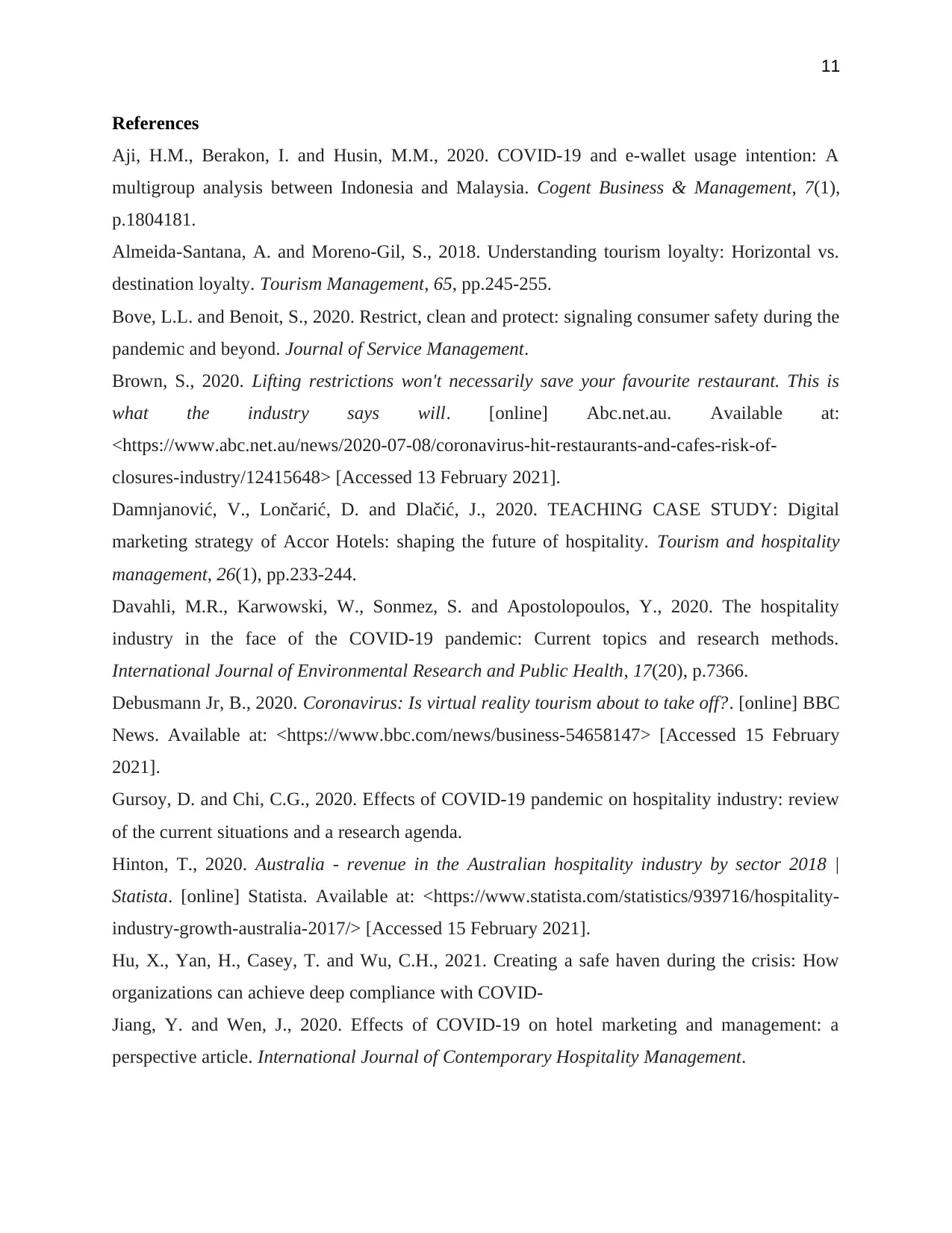
11
References
Aji, H.M., Berakon, I. and Husin, M.M., 2020. COVID-19 and e-wallet usage intention: A
multigroup analysis between Indonesia and Malaysia. Cogent Business & Management, 7(1),
p.1804181.
Almeida-Santana, A. and Moreno-Gil, S., 2018. Understanding tourism loyalty: Horizontal vs.
destination loyalty. Tourism Management, 65, pp.245-255.
Bove, L.L. and Benoit, S., 2020. Restrict, clean and protect: signaling consumer safety during the
pandemic and beyond. Journal of Service Management.
Brown, S., 2020. Lifting restrictions won't necessarily save your favourite restaurant. This is
what the industry says will. [online] Abc.net.au. Available at:
<https://www.abc.net.au/news/2020-07-08/coronavirus-hit-restaurants-and-cafes-risk-of-
closures-industry/12415648> [Accessed 13 February 2021].
Damnjanović, V., Lončarić, D. and Dlačić, J., 2020. TEACHING CASE STUDY: Digital
marketing strategy of Accor Hotels: shaping the future of hospitality. Tourism and hospitality
management, 26(1), pp.233-244.
Davahli, M.R., Karwowski, W., Sonmez, S. and Apostolopoulos, Y., 2020. The hospitality
industry in the face of the COVID-19 pandemic: Current topics and research methods.
International Journal of Environmental Research and Public Health, 17(20), p.7366.
Debusmann Jr, B., 2020. Coronavirus: Is virtual reality tourism about to take off?. [online] BBC
News. Available at: <https://www.bbc.com/news/business-54658147> [Accessed 15 February
2021].
Gursoy, D. and Chi, C.G., 2020. Effects of COVID-19 pandemic on hospitality industry: review
of the current situations and a research agenda.
Hinton, T., 2020. Australia - revenue in the Australian hospitality industry by sector 2018 |
Statista. [online] Statista. Available at: <https://www.statista.com/statistics/939716/hospitality-
industry-growth-australia-2017/> [Accessed 15 February 2021].
Hu, X., Yan, H., Casey, T. and Wu, C.H., 2021. Creating a safe haven during the crisis: How
organizations can achieve deep compliance with COVID-
Jiang, Y. and Wen, J., 2020. Effects of COVID-19 on hotel marketing and management: a
perspective article. International Journal of Contemporary Hospitality Management.
References
Aji, H.M., Berakon, I. and Husin, M.M., 2020. COVID-19 and e-wallet usage intention: A
multigroup analysis between Indonesia and Malaysia. Cogent Business & Management, 7(1),
p.1804181.
Almeida-Santana, A. and Moreno-Gil, S., 2018. Understanding tourism loyalty: Horizontal vs.
destination loyalty. Tourism Management, 65, pp.245-255.
Bove, L.L. and Benoit, S., 2020. Restrict, clean and protect: signaling consumer safety during the
pandemic and beyond. Journal of Service Management.
Brown, S., 2020. Lifting restrictions won't necessarily save your favourite restaurant. This is
what the industry says will. [online] Abc.net.au. Available at:
<https://www.abc.net.au/news/2020-07-08/coronavirus-hit-restaurants-and-cafes-risk-of-
closures-industry/12415648> [Accessed 13 February 2021].
Damnjanović, V., Lončarić, D. and Dlačić, J., 2020. TEACHING CASE STUDY: Digital
marketing strategy of Accor Hotels: shaping the future of hospitality. Tourism and hospitality
management, 26(1), pp.233-244.
Davahli, M.R., Karwowski, W., Sonmez, S. and Apostolopoulos, Y., 2020. The hospitality
industry in the face of the COVID-19 pandemic: Current topics and research methods.
International Journal of Environmental Research and Public Health, 17(20), p.7366.
Debusmann Jr, B., 2020. Coronavirus: Is virtual reality tourism about to take off?. [online] BBC
News. Available at: <https://www.bbc.com/news/business-54658147> [Accessed 15 February
2021].
Gursoy, D. and Chi, C.G., 2020. Effects of COVID-19 pandemic on hospitality industry: review
of the current situations and a research agenda.
Hinton, T., 2020. Australia - revenue in the Australian hospitality industry by sector 2018 |
Statista. [online] Statista. Available at: <https://www.statista.com/statistics/939716/hospitality-
industry-growth-australia-2017/> [Accessed 15 February 2021].
Hu, X., Yan, H., Casey, T. and Wu, C.H., 2021. Creating a safe haven during the crisis: How
organizations can achieve deep compliance with COVID-
Jiang, Y. and Wen, J., 2020. Effects of COVID-19 on hotel marketing and management: a
perspective article. International Journal of Contemporary Hospitality Management.
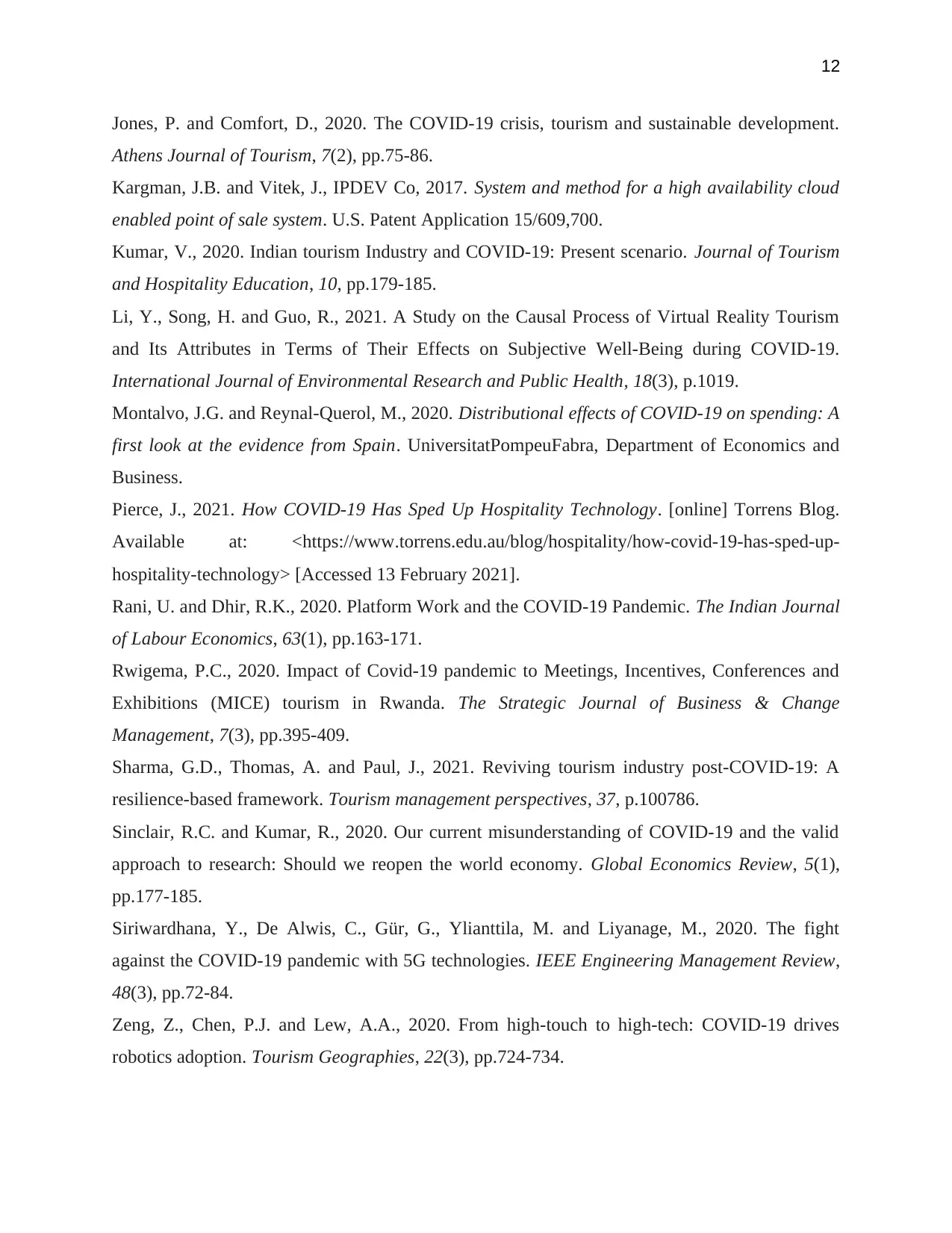
12
Jones, P. and Comfort, D., 2020. The COVID-19 crisis, tourism and sustainable development.
Athens Journal of Tourism, 7(2), pp.75-86.
Kargman, J.B. and Vitek, J., IPDEV Co, 2017. System and method for a high availability cloud
enabled point of sale system. U.S. Patent Application 15/609,700.
Kumar, V., 2020. Indian tourism Industry and COVID-19: Present scenario. Journal of Tourism
and Hospitality Education, 10, pp.179-185.
Li, Y., Song, H. and Guo, R., 2021. A Study on the Causal Process of Virtual Reality Tourism
and Its Attributes in Terms of Their Effects on Subjective Well-Being during COVID-19.
International Journal of Environmental Research and Public Health, 18(3), p.1019.
Montalvo, J.G. and Reynal-Querol, M., 2020. Distributional effects of COVID-19 on spending: A
first look at the evidence from Spain. UniversitatPompeuFabra, Department of Economics and
Business.
Pierce, J., 2021. How COVID-19 Has Sped Up Hospitality Technology. [online] Torrens Blog.
Available at: <https://www.torrens.edu.au/blog/hospitality/how-covid-19-has-sped-up-
hospitality-technology> [Accessed 13 February 2021].
Rani, U. and Dhir, R.K., 2020. Platform Work and the COVID-19 Pandemic. The Indian Journal
of Labour Economics, 63(1), pp.163-171.
Rwigema, P.C., 2020. Impact of Covid-19 pandemic to Meetings, Incentives, Conferences and
Exhibitions (MICE) tourism in Rwanda. The Strategic Journal of Business & Change
Management, 7(3), pp.395-409.
Sharma, G.D., Thomas, A. and Paul, J., 2021. Reviving tourism industry post-COVID-19: A
resilience-based framework. Tourism management perspectives, 37, p.100786.
Sinclair, R.C. and Kumar, R., 2020. Our current misunderstanding of COVID-19 and the valid
approach to research: Should we reopen the world economy. Global Economics Review, 5(1),
pp.177-185.
Siriwardhana, Y., De Alwis, C., Gür, G., Ylianttila, M. and Liyanage, M., 2020. The fight
against the COVID-19 pandemic with 5G technologies. IEEE Engineering Management Review,
48(3), pp.72-84.
Zeng, Z., Chen, P.J. and Lew, A.A., 2020. From high-touch to high-tech: COVID-19 drives
robotics adoption. Tourism Geographies, 22(3), pp.724-734.
Jones, P. and Comfort, D., 2020. The COVID-19 crisis, tourism and sustainable development.
Athens Journal of Tourism, 7(2), pp.75-86.
Kargman, J.B. and Vitek, J., IPDEV Co, 2017. System and method for a high availability cloud
enabled point of sale system. U.S. Patent Application 15/609,700.
Kumar, V., 2020. Indian tourism Industry and COVID-19: Present scenario. Journal of Tourism
and Hospitality Education, 10, pp.179-185.
Li, Y., Song, H. and Guo, R., 2021. A Study on the Causal Process of Virtual Reality Tourism
and Its Attributes in Terms of Their Effects on Subjective Well-Being during COVID-19.
International Journal of Environmental Research and Public Health, 18(3), p.1019.
Montalvo, J.G. and Reynal-Querol, M., 2020. Distributional effects of COVID-19 on spending: A
first look at the evidence from Spain. UniversitatPompeuFabra, Department of Economics and
Business.
Pierce, J., 2021. How COVID-19 Has Sped Up Hospitality Technology. [online] Torrens Blog.
Available at: <https://www.torrens.edu.au/blog/hospitality/how-covid-19-has-sped-up-
hospitality-technology> [Accessed 13 February 2021].
Rani, U. and Dhir, R.K., 2020. Platform Work and the COVID-19 Pandemic. The Indian Journal
of Labour Economics, 63(1), pp.163-171.
Rwigema, P.C., 2020. Impact of Covid-19 pandemic to Meetings, Incentives, Conferences and
Exhibitions (MICE) tourism in Rwanda. The Strategic Journal of Business & Change
Management, 7(3), pp.395-409.
Sharma, G.D., Thomas, A. and Paul, J., 2021. Reviving tourism industry post-COVID-19: A
resilience-based framework. Tourism management perspectives, 37, p.100786.
Sinclair, R.C. and Kumar, R., 2020. Our current misunderstanding of COVID-19 and the valid
approach to research: Should we reopen the world economy. Global Economics Review, 5(1),
pp.177-185.
Siriwardhana, Y., De Alwis, C., Gür, G., Ylianttila, M. and Liyanage, M., 2020. The fight
against the COVID-19 pandemic with 5G technologies. IEEE Engineering Management Review,
48(3), pp.72-84.
Zeng, Z., Chen, P.J. and Lew, A.A., 2020. From high-touch to high-tech: COVID-19 drives
robotics adoption. Tourism Geographies, 22(3), pp.724-734.
1 out of 12
Your All-in-One AI-Powered Toolkit for Academic Success.
+13062052269
info@desklib.com
Available 24*7 on WhatsApp / Email
![[object Object]](/_next/static/media/star-bottom.7253800d.svg)
Unlock your academic potential
© 2024 | Zucol Services PVT LTD | All rights reserved.


